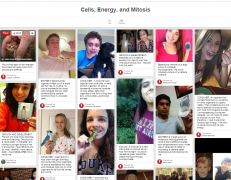This lesson is for : Grade 9,Grade 10,Grade 11,Grade 12:
Summary
Teens love selfies and Pinterest, so why not combine the two? This lesson employs crowdsourcing as an introduction to nearly forty key Biology concepts studied in the course during the year. Crowdsourcing is the process of obtaining information by collecting contributions from a large group of people; in this case, over 200 Biology students from four different teachers. To build a database of Biology terms, each student is assigned two or three terms to research outside of class. After defining each term, students find a physical example from their life and take a selfie with it. These selfies are posted to one of five categorized Pinterest boards, along with a definition of the term and why the found example fits the definition. In class, Biology students interact with the crowdsourced Pinterest boards to research each of the topics, one at a time (e.g., “Arthropods”) to determine which information is the best for their learning. Finally, each student completes a table of terms, displaying their personal understanding of the Biology concepts derived from the crowdsourced collection.
TIPC Ratings
Research & Information Fluency
Rating: Ideal – Explanation:
- In this lesson, over 220 students, from four different teachers, find and share definitions and real-life examples of Biology terms; navigate and evaluate 400+ crowdsourced pins over five categorized Pinterest boards; and synthesize personal understanding of each of the key terms they will be learning in the Biology course.
- Students work as a group, to assemble a large amount of information and examples in a digital collection; and work independently, to synthesize that collection of information into a personalized version of learning of the Biology terms.
- All four teachers and their two-hundred plus students use tools: Pinterest, mobile devices, cameras, and Google drive, to powerfully display, share, and interact with Biology terms.
- Students must construct questions to navigate and evaluate the large collection of crowdsourced information to guide their personalized learning of the Biology terms.
Communication & Collaboration
Rating: Approaching – Explanation:
- In this lesson, over 200 student, from four different teachers, collaborate to crowdsource information and examples towards the common goal of personalizing Biology terms, as well as create a product of five Pinterest boards, that will be used throughout the course.
- Students use Pinterest to collaborate with peers in and out of the Biology classroom regardless of time or distance apart.
Critical Thinking & Problem Solving
Rating: Approaching – Explanation:
- Students use a collection of pins on Pinterest boards to think critically in synthesizing personal learning for a class assignment.
- In navigating and evaluating the large amount of pins for a given term, students must justify decision-making practices in order to select the best information sources.
Creativity & Innovation
Rating: Approaching – Explanation:
- Students synthesize several pins defining a Biology term with existing knowledge to create personal learning.
- Student analysis the large selection of crowdsourced definitions and examples to find solutions to creating personal learning of Biology terms.
- Students create meaningful, personal learning within the assignment parameters that blends technology and personal choice to generate learning.




